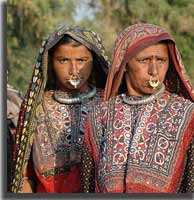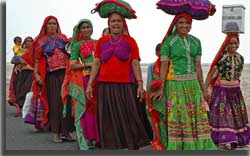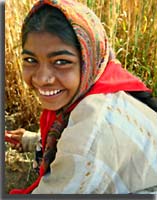History :
The Ahir are believed to be the descandants of Lord Krishna and are caste of cowherds, milkers, and cattle breeders widely dispersed across the Gangetic Plain, especially in the more easternly part (Bihar, Bengal, and eastern Madhya Pradesh, Uttar Pradesh). They lived as shepherds at Gokul Mathura about a thousand years ago. They spread throughout northern and northwestern India. There are four types of Ahir Tribals namely Prantharia, Machhoya, Boureecha, & Sorathia.
The Ahir are almost well over a million today, they numbered 750,000 in the Central Provinces and Berar in 1911, ranking as the sixth-largest caste in terms of numbers. In many castes there is a separate division of Ahirs, such as the Ahir Sunars, Sutars, Lohars, Shimpis, Salic, Guraos, and Kolis. They are named as and the word "Ahir" is derived from "Abhira," a tribe mentioned several times in inscriptions and the Hindu sacred books. "Goala," meaning a cowherd or "a protector of cows," is the Bengali name for the caste and the term "Gaoli" is now used in Madhya Pradesh & Uttar Pradesh State to signify a dairy worker.

Origin
The Ahirs, also referred to as Abhira or Abhir, are one of the ancient martial tribes of India, who ruled over different parts of India and Nepal since ancient times. The word Abhira means "fearless". From the times of the Shakyas, the Kushans and the Scythians (600 BC), Ahirs have been warriors. Some were agriculturists and farmers. Ahirs comprise a subgroup of the Dhangar caste of India. Yaduvanshi - These are prominent in Bihar, Bengal, Maharastra, South India, Uttar Pradesh, Gujrat, Burma, Nepal and Sri Lanka. Nandvanshi - These are prominent in Western UP Etah, Bulandshahar, Agra, Madhya Pradesh, Maharastra, Gujrat, Mathura, Burma, Nepal and Sri Lanka.
Place /Location (then and now) |
Bihar, Madhya Pradesh, Uttar Pradesh & Bengal |
Population |
750,000 |
Languages spoken |
Hindi |
Religion/God |
Hindi |
Food |
Rice, wheat , millet, mutton, chicken, fish & eggs |
Culture
The caste has exogamous sections, which are of the usual low-caste type, with titular or totemistic names. The marriage of persons belonging to the same section and of first cousins is prohibited. A man may marry his wife's younger sister while his wife is living. The practice of exchanging girls between families is permissible. It is argued that foreign hordes from Romak might have settled in India, and incorporated into Ahirs. Sanskrit scholars in India however, have demurred this suggestion.

According to a theory advanced by A. P. Karmakar, Abhiras were a Proto Dravidian tribe, derived from Dravidian Ayir, which means cowherd, he further argues, Aitareva Brahmin refers to Vasah, as the name of people, which in Vedic literature means cow. Finally, he concludes from Padma Purana, where Vishnu informed Abhiras, "I shall be born among you, O Abhiras, at Mathura in my eighth birth". D. R. Bhandarkar supports the non-aryan origin theory, by directly relating Krishna, to Rig Veda's "Krishna Drapsah", where he fights Aryan God Indra. Added to this Karmakar, shows Harivamsa says Yadu was born of Harynasva and Madhumati, who was the daughter of Madhu Rakshasa. Madhu says all the territory of Mathura belongs to Abhiras. Further, Mahabharata describes Abhira as forming one of the seven republics, Samsaptak Gunas, and as a friend of Matsyas, a pre Vedic tribe.
Occupation
Only about 30 percent of the Ahirs are still occupied in breeding cattle and dealing in milk and butter. About 4 percent are domestic servants, and nearly all the remainder were cultivators and laborers in 1931. Formerly the Ahirs had the exclusive right to milk cows, so that on all occasions an Ahir had to be hired for this purpose even by the lowest caste.
People

Young and middle aged women wear Odhanis of red and block striped mashru with embroidered border.
Food
Ahirs are non vegetarian. Their food eat include mutton, chicken, fish and eggs. Wheat and millet are the staple food grains. Rice is prepared during festivals. They also take alcoholic drinks. They smoke bidi and cigarette.
Language
Some dialects named after the Abhira or Ahirs are still spoken. One, known as Ahirwati, is spoken in the Rohtals and Gurgaon districts, the Punjab, and near Delhi. The Malwi dialect of Rajasthani is also known as Ahiri; there is a dialect of Gujarati called Khandeshi, also known as Ahirani. These linguistic survivals are an indication that the Ahirs were early settlers in the Delhi country of the Punjab, and in Malwa and Khandesh. They speak Dhundhari, Hindi and use Devanagari Script.
Festivals
Among the special deities of the Ahirs is Kharsk Deo, who is always located at the place of assembly of the cattle.
Mater Deo is the god of the pen. A favorite saint is Haridas Baba. The main festival is the Diwali, falling about the beginning of November.
All people observe this feast by illuminating their houses with many small saucer-lamps and with fireworks.


